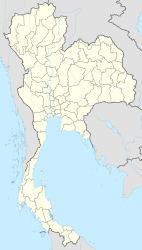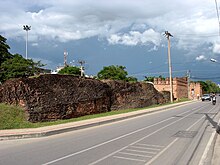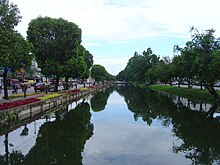Chiang Mai
|
เชียงใหม่ Chiang Mai |
||
|---|---|---|
|
|
||
| Coordinates | 18 ° 47 ′ N , 98 ° 59 ′ E | |
| Symbols | ||
|
||
| Basic data | ||
| Country | Thailand | |
| Chiang Mai | ||
| ISO 3166-2 | TH-50 | |
| Residents | 135,757 (2012) | |
| politics | ||
| mayor | Tatsanai Puranupakorn | |
|
View of Chiang Mai from Doi Suthep
|
||
Chiang Mai (also Chiengmai , Xiang Mai or Kiangmai , ( tʃæŋˈmaɪ , from เชียงใหม่ tɕʰīəŋ màj , , Lanna : ᨩ᩠ᨿᨦ ᩲᩉ᩠ᨾ᩵ t͡ɕīəŋ.màj )) is a large city ( เทศบาลนครเชียงใหม่ ) in the Thai province of Chiang Mai . It is the capital of Mueang Chiang Mai County ( Amphoe ) and the capital of Chiang Mai Province. With its 135,757 inhabitants, it is the largest and culturally most important city in the northern region of Thailand and is also called the Rose of the North because of its scenic beauty .
location
Chiang Mai is located in a sheltered river valley of the Mae Nam Ping , at the foot of the Doi Pui mountain (1685 m above sea level).
The provincial capital is the economic and cultural center of the north. The earlier tranquility has given way to a western hectic pace, many old teak houses have been replaced by concrete buildings. This makes the enormous contrast to the mountain people ( Akha , Meo , Lisu , Karen, among others ) who settle outside the city in the traditional way , abundantly clear.
Chiang Mai has a total of around 200 Buddhist temples ( wat ) , many of which are in the old town. This is surrounded by a square from the ancient city wall (remnants of it are still preserved) and a water ditch running parallel to it, which can be crossed on numerous bridges. The center of the modern city, on the other hand, lies to the east outside the former city walls on the banks of the Mae Nam Ping.
economy
Chiang Mai is the center of Thai handicrafts . In particular, wood processing, textile production and the processing of jade jewelry are important branches of the economy. Chinnaraje , a manufacturer of auto rickshaws (tuk-tuk), was based in the city. Tourism is also an important source of income for many people.
traffic
Chiang Mai International Airport is located on the western edge of the city . From here, destinations in Thailand and Southeast Asia, as well as various Chinese cities, are served daily.
There are regular train connections to Bangkok . There are also numerous bus connections from southern, central and northern Thailand to Chiang Mai.
On site include Songthaeos to major transport. The red shared taxis are omnipresent in the cityscape of Chiang Mai.
education
The Chiang Mai University (Thai: มหาวิทยาลัย เชียงใหม่ , Engl .: Chiang Mai University - in short CMU), the main public university in northern Thailand, located about five kilometers west of the center of Chiang Mai below the mountain Doi Suthep . In Chiang Mai there are the following universities with a variety of subdivisions:
- the Rajabhat University of Chiang Mai
- the private Payap University (Christian)
- the private Far Eastern University
- the Lanna campus of the Mahamakut Buddhist University ( Thammayut Nikaya ) in Wat Chedi Luang
- the Chiang Mai campus of the Mahachulalongkornrajavidyalaya Buddhist University (in Tambon Suthep, Amphoe Mueang Chiang Mai )
Also close to Chiang Mai are:
- the Maejo University (about 14 km)
- the private North-Chiang Mai University (about 17 km)
- the Technical University of Rajamangala Lanna (about 20 km)
At the Christian German School Chiang Mai (CDSC) in northern Thailand there is the opportunity to obtain a German-language international Abitur (DIAP). The school carries the seal of approval "Excellent German School Abroad". It is one of the 140 German Schools Abroad (DAS) currently funded by the Federal Republic of Germany . The #CDSCWald project was started in autumn 2019 in order to plant 1/2 hectare of forest in June 2020 as #trees for the future. The little trees to be planted are grown by the students themselves in a small tree nursery built for this purpose. A model combination of education and practiced climate protection.
history
Chiang Mai was founded in 1296 by King Mangrai as the capital of his kingdom Lan Na ("land of a million rice fields"). After the subjugation of the Mon empire Haripunchai, Chiang Mai became the capital of Lan Na. In 1556 the Burmese were able to make Lan Na their vassal and it was not until 1775 that Chiang Mai came to Thailand under General Taksin , but retained a quasi-autonomous status until 1932.
Town twinning
- Chongqing , People's Republic of China
- Harbin , People's Republic of China
- Kunming , People's Republic of China
- Saitama , Japan
- Uozu , Japan
Attractions
In 2015, the monuments, sites and cultural landscape of Chiang Mai were added to the Thai list of proposals for UNESCO World Heritage Sites .
Buddhist temples
- Wat Phra That Doi Suthep - founded probably in 1371, today's appearance since 1805, situated high on Doi Suthep above Chiang Mai (the road there was only built in 1935), with great views over the whole valley.
- Wat Phra Singh - Buddhist temple complex ( Wat ) , built in 1345 under King Pha Yo, with the Buddha figure Phra Sihingh, wood carvings of the portals, gem-studded bronze statue, small library building from the 14th century.
- Wat Chiang Man - with the so-called "crystal Buddha" made of rock crystal , from the 7th century, captured by King Mangrai during the conquest of Haripunchai.
- Wat Chiang Yuen - National Temple of the Kingdom of Chiang Mai, north of the old town surrounded by a wall and moat.
- Wat Chedi Luang - with the ruins of a huge chedi that was destroyed by an earthquake in 1545. In the northern part of the small viharn , built in honor of the meditation master Ajahn Mun Bhuridatta, who lived and taught here.
- Wat Lok Mo Li - renovated 14th century Buddhist temple.
- Wat Buppharam - on Tha Pae Road temple from the end of the 15th century, renovated in the 19th century with an unusual Burmese style viharn.
- Wat Suan Dok - 14th century temple west of the old town.
- Wat Chet Yot - temple with an unusual viharn from the 15th century.
- Wat Umong - temple from the 14th century in the forest, on the outskirts of the city, with a large pond (feeding fish).
Museums
- National Museum Chiang Mai - founded in 1973, shows pieces from the history of Lan Nas as well as a beautifully designed wooden footprint of the Buddha .
- Tribal Museum of Chiang Mai - shows the art and culture of the hill tribes and explains their history.
various
- Night Bazaar (Night Bazaar) - near the banks of the Ping; Every evening local products, victuals and textiles (especially from mountain people) are for sale here. Several food courts and numerous cookshops cater to the physical well-being of both locals and tourists.
- Wiang Kum Kam - historical excavation area about five kilometers south of the city. King Mengrai lived here before founding Chiang Mai.
- Chiang Mai Night Safari - zoo and amusement park with restaurant and water light games, some with outdoor enclosures, through which you are driven in small trains in the evening. 10 km outside the city.
- Royal Flora Expo (Thai: งาน มหกรรม พืช สวน โลก 2006 - [ ŋaːn.má.hà.kam.pʰɯ̂ːt.sǔːan.lôːk.2006 ], also: ราชพฤกษ์ 2549 - [ râːt.tɕʰá.pʰrɯ́k.2549 ]) - International Garden Show, Among other things, huge halls with orchids, very elaborate, very spacious, located about 10 km southwest of the old town.
- At the station: Monument steam locomotive RSR No. 340, ex G 4/5 118 of the Rhaetian Railway (Graubünden, Switzerland), SLM 2208, 1912, in Thailand since 1926 (sister locomotives 107 and 108 operational on the RhB)
- Kawila Race Track: Horse racing track where horse races take place every Saturday from 12:30 p.m. and where betting is legal.
- Elephant Nature Park: Sustainable elephant park as an elephant rehabilitation center
- City fortifications of Chiang Mai - Originally from the late 13th, the present-day appearance dates from around 1801. All city gates and citadels have been preserved or reconstructed.
Personalities
- Phitchanon Chanluang (born 1997), football player
- Prin Goonchorn (* 1995), soccer player
- Supakit Jinajai (* 1979), football player
- Noppakun Kadtoon (* 1994), soccer player
- Nuttawut Khamrin (* 1991), football player
- Panudech Maiwong (* 1996), football player
- Kansit Premthanakul (born 1991), football player
- Chaowat Veerachat (* 1996), football player
- Sarawut Yodyinghathaikul (* 1999), football player
See also
Individual evidence
- ↑ City Council website (in Thai - accessed November 28, 2015)
- ↑ Department of Provincial Administration : As of 2012 (in Thai)
- ↑ CDSC nursery opens .
- ^ Chongqing Municipal Government
- ↑ Monuments, Sites and Cultural Landscape of Chiang Mai, Capital of Lanna on the official UNESCO World Heritage website, accessed on May 11, 2017.
- ^ Alfred Moser: Der Dampfbetrieb der Schweizerischen Eisenbahnen 1847–1966 , p. 341/406 ISBN 3-7642-0742-0 , current photo (2009) by James Waite, England
Web links
- City Council website (in Thai)
- Things to do and travel tips for Chiang Mai
- Link catalog on Chiang Mai at curlie.org (formerly DMOZ )









